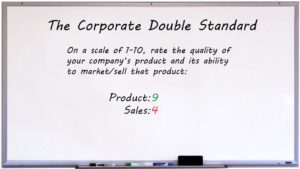The Corporate Double Standard

On a scale of 1-10, with 10 being best, rate the quality of products and/or services.
On the same 1-10 scale, rate your ability to market and sell those products and/or services.
After asking hundreds of CEOs these two questions, an overwhelming trend has emerged: most rank products and services an eight or better but marketing and sales a five or worse. This discrepancy is symptomatic of a pervasive double standard in which businesses tolerate (and don’t invest in improving) sub-par performance in marketing and sales which they would never tolerate in product quality. This is driven by two primary reasons:
1. Product excellence is mandatory
2. Sales and marketing are perceived as “soft-cost” investments
The great irony is that achieving product excellence – the primary motivation behind the imbalance – actually requires greater investment in frontend marketing and sales.
Just about every market has casualties of this double standard: quality products that struggle to sell. When companies develop products before testing the market then later develop messaging, they often fail to effectively match product offerings with customer needs. Because the product is of a high quality, they blame marketing and sales and think it a wasted investment. So, to address poor sales they invest in further product development without testing the market. A vicious cycle ensues.
Let’s look for example at the hyper-competitive $90 billion global gaming industry.
In 2005, Sony entered the handheld gaming market with the PlayStation Portable. According to Gizmodo “while the PSP was a technically superior device, it could never compete with the [Nintendo] DS’s durability or price.” Still, Sony continued to invest in their handheld hardware releasing the PSP Go in 2009 – a smaller evolution of the PSP with downloaded games rather than hardware discs. But between 2005 and 2009 the consumer market for small portable entertainment devices with downloadable content had shifted to the smartphone. PSP Go sales were paltry.
In contrast, in November 2016 Nintendo launched the NES Classic Edition, a mini version of a 20-year-old console preloaded with a static library of 30 games. In the roughly five months the console was available, gamers foraged stores and waited in lines to purchase one of the 2.3 million units sold before Nintendo cut off production. Nintendo then rode the wave of popularity to promote their latest generation console and future classic console releases.
What’s the difference between Sony’s PSP Go flop and Nintendo’s NES Classic Edition success? Sony developed a product and then tried to find a market. Nintendo went to the market and discovered an opportunity. One developed an impressive technical achievement few demanded; the other delivered nostalgia. One had a double standard; the other was balanced.
IntelliSource helps clients achieve this balance and build a position around the promise of a result. One such client was Mar-Lee Companies, a plastics OEM with an advanced “Technology Center” that delivered exceptional services but operated at breakeven. During our research, IntelliSource identified the medical device market as one which required the manufacturing expertise and was willing to pay a premium for it. IntelliSource reposition and rebranded the Technology Center “Mar-Lee Medical.” By balancing technical superiority with effective marketing, Mar-Lee was able to position their services to ideal target customers and transform a breakeven operation into breakout success.
Are you guilty of the double standard? A balanced and effective business requires both strategy (knowing where to go) and tactics (knowing how to get there). Learn more about IntelliSource’s approach to both by reading about Our Process.

